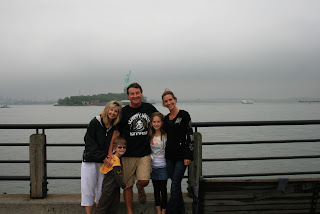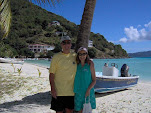We left Great Bridge, Virginia on May 27, and moved twelve miles downriver to Portsmouth. While we stopped at a marina merely to get charts of the Chesapeake, the dockmaster convinced us that moving on without seeing his part of the world would be a huge mistake. We were happy he was such a good salesman. After touring the city's historical district, we took a paddle wheel ferry across the river to Norfolk, where we visited "Nauticus", a great marine and naval museum which includes entry to the battleship Wisconsin. As home to the navy's Atlantic fleet, Norfolk is a vibrant city, and as we left, we were awed by the dozens of naval vessels of every size and description.
Now moving up Chesapeake, we arrived in Yorktown, famous as the site where George Washington defeated Cornwallis in the last significant battle of the Revolutionary War. Docked at the new Riverwalk Landing, with its interesting shops and restaurants, we found Yorktown to be a fun, pretty place.
To us, boating up the Chesapeake was very much like boating on the Great Lakes, particularly similar to the area on the Michigan side of Lake Michigan, with its many interesting natural ports, with cities and towns often situated on connecting rivers or lakes. Boaters could spend a lifetime of summers exploring the Chesapeake. For our part, we chose to bypass the larger cities such as Washington, D.C., Baltimore, and Annapolis, to instead visit smaller towns, most of which, we found, could boast of a rich and colorful watermans' heritage. Deltaville, the first such town, was once a famous boat building center, but now depends largely on the yachting scene. With only 800 permanent residents, it is home to over 3,000 boats! To us it will also be memorable as the place where in the first time in 16 years and over 24,000 cruising miles, we grounded our boat. Leaving through a serpentine channel, which seemed about two feet wide, we hit the sand bottom. Fortunately, a Good Samaritan pulled us off in about ten minutes, with no apparent damage to the boat.
Moving north up the Bay, we next visited the towns of Solomons, St. Michaels and Rock Hall, each proud of a history tied to fish, oysters, clams, and blue crabs. For three days, we stayed at Solomons, where one day we enjoyed a fantastic seafood lunch at a waterfront restaurant, then brought back crab cakes, fresh shrimp, and phenomenal seafood salad from a gourmet food store. Then, at St. Michaels, arguably one of the most popular cruising destinations on the Chesapeake, we found dozens of quaint shops and quality restaurants in a setting that somehow escapes that "touristy" feel. We spent two days there, exploring it and the surrounding area by bike. Rock Hall, our last stop on the Bay, was refreshing in that it has retained much of its watermans' heritage as a still-working port. Though oyster harvests aren't what they once were, you can still watch watermen bring in crabs, rockfish (stripped bass), and clams.
After moving through the C&D (Chesapeake & Delaware) Canal and then south through the Delaware Bay, we rounded the Cape May light and docked at Canyon Club Marina. With its sport-fish battle wagons lined up at the docks ready to speed to the offshore "canyons", it's easy to see how the marina gets its name. For two days, we biked past Cape May's beautiful beaches, historic WWII beach bunkers and spotting towers, as well as its famous Victorian homes and hotels.
Then, because of a tight weather window we headed up the Atlantic past Atlantic City (that's O.K.--been there, done that), straight to the Big Apple. Passing under the Verrazano Bridge, we entered the Port of New York, stopped to enjoy the Statue of Liberty, and then, less than a half mile up the Hudson, hung a left to Liberty Landing Marina.
This marina, we found, was the perfect home base for us to enjoy the city. From it, we could (and did) take a ferry across river to the financial district to enjoy the city. From our boat, the view of Manhattan and the financial district was spectacular, especially after dark when the lights of the skyscrapers brightened up the night sky.
As part of Liberty State Park, it was near walking trails which passed near the historical triumvirate of the Statue of Liberty, Ellis Island, and the CRRNJ railroad and ferry terminal, which funneled seventy percent of Ellis Island immigrants to the rest of the country.
We found this location a great place to take on guests, and during our stay there, we enjoyed the company of Linda's brother, Dennis, from Scranton, as well as our daughter and grandkids, Jennifer, Courtney, and Carter, and Jen's friend, Scott, all from nearby Connecticut. Jen and the kids especially enjoyed seeing the Statue of Liberty, Ellis Island, and the railroad station up close from the walking path, as well as the world class hand-on science center and Imax theater, also part of the park. A photo in this post shows Jen and Courtney in a wind tunnel designed to demonstrate the power of hurricane force winds and rain.
Following NYC, we travelled past the impressive Palisades on the Jersey side of the Hudson, passed by the fortress-like buildings of West Point, then cruised through the breathtaking fifteen mile long Hudson River Gorge.
Further along, we passed by "Bannermans' Island" with its impressive Scottish castle-like ruins, then past Hyde Park, where we could catch a brief glimpse of the Roosevelt house.
After seeing lots of barge traffic and interesting light houses along the way, we finally hung a left off the Hudson into Rondout Creek to berth at Kingston, N.Y., our last stop before Troy, the gateway to the Erie Canal.



























